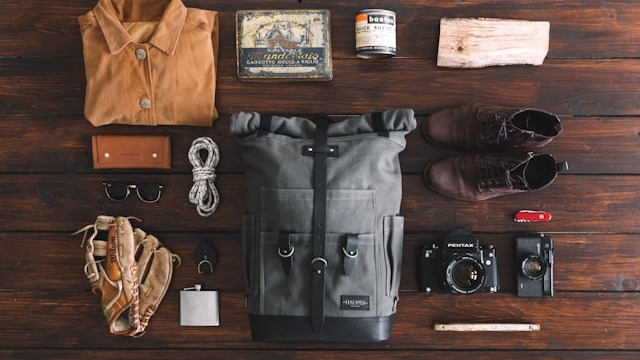 Work and Travel
Work and Travel Expedia: Is it safe to book here? Pros, cons, and user reviews
With Expedia you can search, compare, and book accommodations, plane tickets, and more. Here we tell you the advantages and disadvantages of Expedia.



Choosing the wrong backpack will only lead to frustration during your trip. The thing is, in 2025, the options are more varied than ever.
There are backpacks made with ultralight materials, anti-theft designs, and features tailored for every type of traveler. That’s why we’ve put together a guide to help you find the backpack you need.
We’ll tell you what aspects to consider when choosing a travel backpack, the technical details, and the types of backpacks available. Plus, at the end, we’ll share some tips to make your decision easier.
Choosing a backpack might not seem as important as other travel tips—but it is. It can make the difference between a comfortable trip and one full of inconvenience.
Now, to buy the right one, keep this in mind:
Each type of backpack serves a different purpose. It’s not the same to tour European cities for two weeks as it is to go hiking in South America for a month.
So, the first step is to define where you’re going and what you’ll use it for. Do you need a backpack for long or short trips? Will you visit several countries or go trekking in the mountains?
The more days you’re away, the more space you’ll need.
Also, consider your travel style.
Are you someone who prioritizes mobility? Or are you looking for backpacks with space for gadgets, extra clothes, or special items?
How you travel matters just as much as your destination.
A backpack should be:
Versatile. Many models work well both in urban environments and nature. But others are designed for more specific use.
Accessible. Some models are easy to open, and others come with separate compartments that prioritize organization.
Ideally, your backpack should be easy to handle and also suit your travel type.
A comfortable backpack, with good weight distribution and features, will give you peace of mind throughout your journey.
Ergonomics, strap design, and lumbar support are key factors—especially if you’ll be hiking. When it comes to safety, some features can help you travel with greater peace of mind, like hidden zippers.
And of course, you need to consider your budget.
There are excellent options in all price ranges depending on the type of trip. The important thing is to find a model that fits your real needs—without overpaying for features you won’t use.
Technical details will help you understand which features best suit your body and the type of trip you’re planning:
For your comfort, your travel backpack should fit your body and travel style.
Capacity is measured in liters:
For short getaways, go for a backpack between 30 and 40 L.
For longer trips, opt for one between 45 and 60 L.
As for size, it should match the length of your back (from the base of the neck to the waist) to ensure good posture.

Lightweight backpacks may seem appealing, but some compromise on structure and durability.
What matters here is:
A 50–60 liter backpack should weigh no more than 2.4 kg when empty.
Smaller models should weigh around 1 kg.
The key is finding one that’s light yet sturdy, so you don’t overload your back.
This belt is essential in large travel backpacks, as it shifts the weight to the hips—relieving pressure from the shoulders and back.
Not all backpacks have one, but if you plan to carry heavy loads or walk for hours, choose one with a padded, adjustable hip belt that rests on your pelvis.
Shoulder straps should be padded, wide, and adjustable to fit your body. Note that nowadays, there are travel backpacks designed specifically for men and women.
Women’s models often have chest and waist contours tailored for a more anatomical fit. Also, the best backpacks let you adjust the strap height and angle to match your build.
These help you stay organized. They usually feature inner dividers, side or front access, plus space for a water bottle, laptop, shoes, etc.
When choosing a backpack for travel, it is key to look at the quality of manufacture:
Models made with ripstop nylon or reinforced polyester stand up well to continuous use and abrasion. In addition, some are waterproof in case the rain surprises you.
If it has zippers, check that they slide easily, even when the backpack is full.
If you opt for waterproof backpacks, you may have to invest a little more money. Another solution is to buy a separate cover to save money and protect it from water and dirt.
Each trip requires a different type of backpack depending on the experience you plan to have, the length of the trip and your personal style.
Among the most common types of backpacks for travel are:
It is the typical small model of 15 to 25 liters. Ideal for carrying the essentials during the day, short excursions or as a complement to your suitcase. Some even come as a detachable backpack in larger models.
Suggested model: Matador DL16 Packable Daypack.

This backpack offers good capacity (16 L) in a compact and water resistant design. Ideal to carry in your suitcase as a secondary backpack if you are traveling to Japan or any destination where you will be doing a lot of walking.
Pros | Cons |
Minimalist and discreet design. Ultra-lightweight and folds to the size of one hand. Side pockets for bottles or small items. Water resistant. | Front pocket is deep and impractical for small items. |
These are the kind of backpacks for air travel, those that comply with the baggage restrictions of low cost airlines. They usually have a capacity between 20 and 40 liters and are useful for short trips or minimalist travel.
Suggested model: SZLX travel backpack 40x20x25 cm.

The SZLX backpack has a suitcase-like opening, multiple functional compartments, space for laptop and water resistant material. It is a type of backpack for air travel, available for women and men.
Pros | Cons |
Spacious and with multiple compartments. Resistant and waterproof material. Complies with hand luggage regulations. Padded, breathable back and light weight. | Somewhat stiff zippers. Loses shape if not well filled. |
These are backpacks for long trips, with capacities ranging from 45 to 70 liters. They usually come with a lumbar belt, adjustable straps and multiple compartments to organize all luggage.
Suggested models:
Budget option | Pros | Contras |
Strong price-performance ratio for beginner backpackers. Comfortable suspension system for moderate loads. Several external compartment options. | Limited ventilation and small belt pockets. |

Premium Option | Pros | Contras |
Anti-Gravity Suspension offers exceptional comfort and ventilation. Excellent load distribution and customizable adjustments. Enough space to carry extra/bulky gear. | Relatively high weight (over 2 kg). |

They are designed for demanding routes, such as hiking. Its structure is rigid, with a large capacity and advanced rear ventilation system.
Suggested model: Forclaz Travel 900 60+6 L.

The Forclaz Travel 900 60+6 L is designed for women who go on long trips or trekking routes with a full load. It allows you to organize everything you need and is a practical option for everyday use.
Pros | Cons |
Large total capacity of 66 L (60 + 6 L). Detachable 6 L secondary backpack. With waterproof cover. Hollow back and aluminum frame for good ventilation and comfort. | Can be bulky if you need to move fast or in tight areas. |
These are backpacks for air travel, more compact, discreet and with hidden or reinforced zippers. Perfect for day-to-day, urban travel or touring tourist sites in the United States with greater peace of mind.
Suggested model: Pacsafe Metrosafe X.

If you are looking for a model designed to protect your belongings, the Pacsafe Metrosafe X Anti-Theft 20 L Backpack is a good choice.
Pros | Cons |
Cut resistant fabric. RFID pocket to protect documents and cards. Several well organized compartments. With laptop sleeve. | Straps may be a little stiff if you carry a lot of weight. |
As you can imagine, it combines a backpack and suitcase design with wheels. Useful if you don't want to carry weight all the time, although they are usually heavier and less ergonomic.
Suggested model: Samsonite Paradiver Light.

The is a useful hybrid option if you prioritize comfort without sacrificing capacity.
Pros | Cons |
It can be used as a wheeled suitcase or as a backpack. Multiple handles (top / side). Modern and attractive aesthetics. Ideal for those who do mixed tours (airport, train, walking tour). | Slightly heavier than backpack-only options. |
Choosing a travel backpack can be as complex as choosing a gift for Mother's Day. The market has many options, styles and sizes, and finding the right one won't be so simple, depending on your needs as a traveler.
The right one depends on your needs as a traveler.
Have you already decided on the ideal backpack for your adventure? How about buying it with a global card that adapts to your needs?
The DolarCard from DolarApp works with digital dollars (USDc) and is a practical option to buy on international websites without complications. This means that there will be no fees for converting your money to dollars. An advantage that conventional credit cards do not offer.
Once you have your backpack ready, organize your itinerary with tools like Google Travel. This way, you can manage flights, accommodations and activities from one place.

Los países tienen fronteras. Tus finanzas, ya no.
 Work and Travel
Work and Travel With Expedia you can search, compare, and book accommodations, plane tickets, and more. Here we tell you the advantages and disadvantages of Expedia.

 Work and Travel
Work and Travel Expedia TAAP Mexico could be the competitive advantage your agency is looking for. Discover how to register and how you can boost your income.

 Work and Travel
Work and Travel Build your own kit with the best travel apps to plan, book, and manage every trip detail from your phone.


